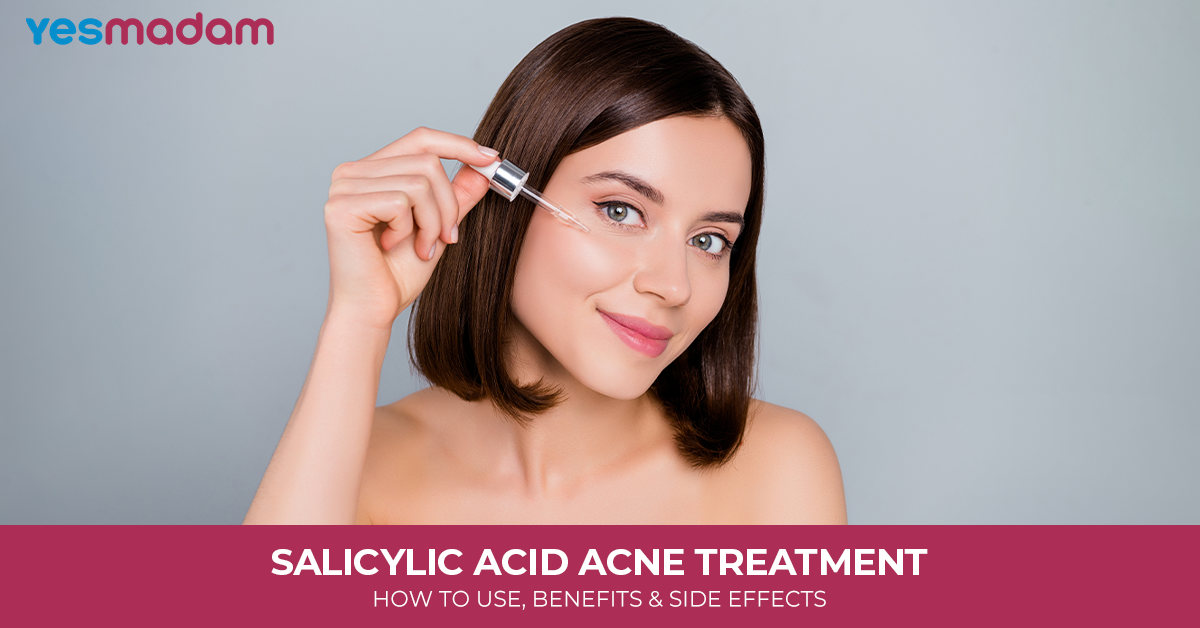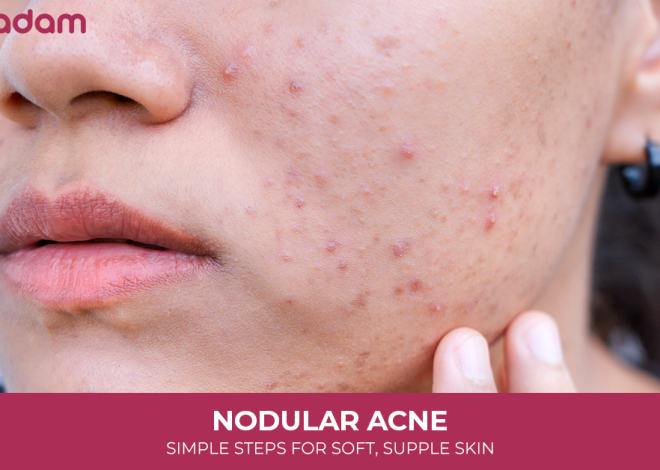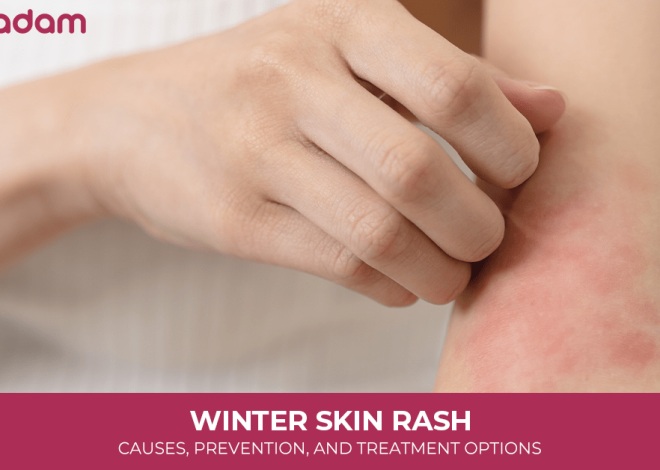
Salicylic Acid Acne Treatment: How To Use, Benefits, and Side Effects
Salicylic acid needs no introduction in the skincare domain. It is a wonderful exfoliator that deep cleans your pores and helps minimize acne. It is an oil-soluble beta-hydroxyl acid (BHA) that works by penetrating your skin and dissolving dead skin cells, effectively inhibiting them from clogging up pores. This aids in reducing acne formation.
Read this guide on salicylic acid acne gel to discuss the effectiveness of salicylic acid in fading acne scars.

Table of Contents
What is Salicylic Acid?
Salicylic acid is a kind of exfoliating agent that dissolves the bond holding dead skin cells together. This causes the dead skin cells to shed more easily, thereby revealing new , healthy skin underneath. All in all, it is an excellent exfoliator for acne-prone skin.
How Salicylic Acid Works on Acne?
Acne is the direct result of excess sebum(Skin oil) and dead skin cells clogging the skin pores. This congestion, in turn, leads to blackheads, whiteheads, or pimples.
By penetrating your skin and dissolving the bond holding the dead skin cells, salicylic acid minimizes the chances of whiteheads and blackheads formation, two prominent types of acne.
Salicylic Acid on Acne Scars Effects
Salicylic acid reduces the appearance of acne scars through its best skin-renewal properties :
Exfoliation
Using salicylic acid for acne scars helps it penetrate the skin and remove dead skin cells, excess oil, and dirt that contribute to scarring. Its exfoliating effect unclogs pores and boosts cell turnover, revealing fresh new skin underneath.
Reducing hyperpigmentation
The exfoliating effect progressively reduces the appearance of dark spots and uneven skin tone borne out of earlier acne breakouts by stimulating the shedding of damaged and discoloured skin cells.
Anti-inflammatory
Salicylic acid, because of its anti-inflammatory properties, can help to improve the appearance of acne scars. It helps make the scars less visible and also reduces redness and inflammation.

How to Use Salicylic Acid for Acne Scars?
The following are some tips indicating how can salicylic acid remove acne scars effectively.
- Begin with a small quantity of salicylic acid and increase the quantity gradually as your skin is ready to tolerate it.
- On the affected part, apply salicylic acid serum one or two times a day.
- Include broad-spectrum SPF 30 + sunscreen when you apply salicylic acid.
- Discontinue using salicylic acid in case of any irritation or side effects.
These tips demand patience and regular use so that salicylic acid fades acne scars and makes them appear less noticeable.
How Long Does It Take for Salicylic Acid to Fade Acne Scars?
It usually takes several weeks to a few months to show noticeable results in fading acne scars, depending on the severity of the scarring and the individual’s skin type.
Here’s a more detailed breakdown:
Initial Improvement: For superficial scars and hyperpigmentation, you might start noticing a reduction in redness and slight fading of dark spots within a couple of weeks.
Regular Use: Continued and consistent usage is crucial for more noticeable results. Salicylic acid works by exfoliating the skin and promoting new cell growth, so consistent use is key.
Significant Changes: More noticeable improvements in superficial scars and pigmentation typically occur within 4-6 weeks of consistent use.
Deeper Scars: Deeper scars may take 3-6 months or longer to show significant improvement, and in some cases, even longer, depending on the severity and individual factors.
Consistency and Sunscreen: Consistency with salicylic acid, both morning and evening, and regular use of sunscreen to protect against sun damage are important for maximizing results and preventing further pigmentation.
Forms and Use Cases of Salicylic Acid Acne Treatment
| Form of salicylic acid | Percentage (%) | Use case | Skin type/acne severity |
| Gel | 2-7 % | High-strength exfoliation and peeling. | Severe acne, under a dermatologist’s guidance. |
| Lotion | 2 % | Hydration with a mild exfoliating effect to prevent acne flare-up. | Dry, sensitive, acne-prone skin. |
| Cleanser | 0.5 – 2 % | Pore cleansing daily, mild exfoliation, and oil control. | Combination, oily, and acne-prone skin. |
| Toner | 0.5 – 2 % | PH balance, reduced pore appearance. | Ideal for mild acne, blackheads. |
| Face mask | 1-2% | Removes impurities and unclogs pores through cleansing. | Oily skin, congested skin. |

Potential Side Effects of Salicylic Acid
Although salicylic acid is a safer option to treat acne, some of its potential side effects include :
- Skin irritation and dryness
- Peeling skin
- Itching
- Skin tingling or stinging
- Hives
Conclusion
Salicylic acid acne treatment is a saviour of sorts when there is no guaranteed cure for acne. However, things will not transform overnight. Patience and consistent use are important to reap the maximum benefits.
Thus, do give it a shot and see for yourself, is salicylic acid good for acne scars or not, and whether this single ingredient can do wonders for your skin type.
FAQs
Is it possible to use salicylic acid for fungal acne treatment?
While salicylic acid is beneficial for certain kinds of acne, it’s generally not recommended to treat fungal acne.
Is salicylic acid good for acne?
Yes, salicylic acid is the best bet, especially for comedonal acne (blackheads and whiteheads).
Does 2% salicylic acid remove acne?
Yes, 2% salicylic acid is effective in reducing acne. It removes dead skin cells, unclogs pores, and reduces oil production.
Can salicylic acid cause acne?
Salicylic acid can temporarily cause an increase in acne, a phenomenon called skin purging, when first incorporated into a skincare routine.
Does salicylic acid remove acne scars?
While Salicylic acid can help reduce the appearance of acne scars, it won’t eliminate them, especially deep scars.
Can I use salicylic acid daily?
Yes, it is possible to apply salicylic acid regularly using correct application techniques as per your skin needs.
Does salicylic acid lighten skin?
While salicylic acid does not directly make your skin white, it can help improve skin tone and brightness by scrubbing away dead skin cells.
Can I apply salicylic acid to active acne?
Yes, but it’s crucial to do it correctly to prevent skin irritation and dryness.
Which acid is best for acne scars?
Salicylic acid is best. It helps prevent new breakouts and potential scarring while also smoothing out existing uneven texture.
Is salicylic acid or vitamin C better for acne scars?
Salicylic acid is a natural choice for acne removal or acne-prone skin, while vitamin C can help brighten and fade scars.



